Related Research Articles

The Divine Comedy is an Italian narrative poem by Dante Alighieri, begun c. 1308 and completed around 1321, shortly before the author's death. It is widely considered the pre-eminent work in Italian literature and one of the greatest works of world literature. The poem's imaginative vision of the afterlife is representative of the medieval worldview as it existed in the Western Church by the 14th century. It helped establish the Tuscan language, in which it is written, as the standardized Italian language. It is divided into three parts: Inferno, Purgatorio, and Paradiso.

Purgatorio is the second part of Dante's Divine Comedy, following the Inferno and preceding the Paradiso. The poem was written in the early 14th century. It is an allegory telling of the climb of Dante up the Mount of Purgatory, guided by the Roman poet Virgil – except for the last four cantos, at which point Beatrice takes over as Dante's guide. Allegorically, Purgatorio represents the penitent Christian life. In describing the climb Dante discusses the nature of sin, examples of vice and virtue, as well as moral issues in politics and in the Church. The poem posits the theory that all sins arise from love – either perverted love directed towards others' harm, or deficient love, or the disordered or excessive love of good things.

Grosseto is a city and comune in the central Italian region of Tuscany, the capital of the Province of Grosseto. The city lies 14 kilometres from the Tyrrhenian Sea, in the Maremma, at the centre of an alluvial plain on the Ombrone river.
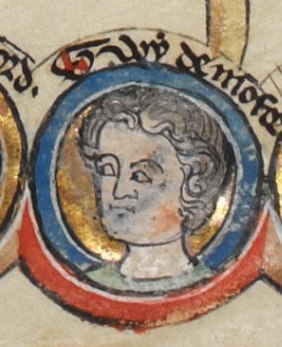
Guy de Montfort, Count of Nola (1244–1291) was the son of Simon de Montfort, 6th Earl of Leicester and Eleanor of England.

The Battle of Montaperti was fought on 4 September 1260 between Florence and Siena in Tuscany as part of the conflict between the Guelphs and Ghibellines. The Florentines were routed. It was the bloodiest battle fought in Medieval Italy, with more than 10,000 fatalities. An act of treachery during the battle is recorded by Dante Alighieri in the Inferno section of the Divine Comedy.
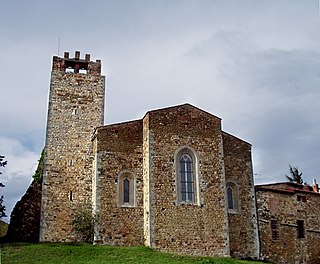
Campagnatico is a comune (municipality) in the Province of Grosseto in the Italian region Tuscany, located about 100 kilometres (62 mi) south of Florence and about 20 kilometres (12 mi) northeast of Grosseto in the valley of the Ombrone River.

Gavorrano is a mountain-side comune (municipality) in the Province of Grosseto in the western Italian region of Tuscany, located about 100 km (62 mi) southwest of Florence and about 25 km (16 mi) northwest of Grosseto. Gavorrano borders the municipalities of Castiglione della Pescaia, Grosseto, Massa Marittima, Roccastrada and Scarlino.

Roccalbegna is a comune (municipality) in the Province of Grosseto in the Italian region Tuscany, located about 110 kilometres (68 mi) south of Florence and about 35 kilometres (22 mi) east of Grosseto.
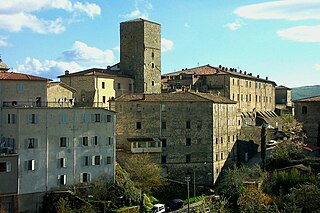
Santa Fiora is a comune (municipality) in the Province of Grosseto, in the Italian region of Tuscany, located about 110 kilometres southeast of Florence and about 40 km (25 mi) east of Grosseto. Santa Fiora borders the following municipalities: Abbadia San Salvatore, Arcidosso, Castel del Piano, Castell'Azzara, Piancastagnaio, Roccalbegna, and Semproniano. It is a member of the I Borghi più belli d'Italia association.
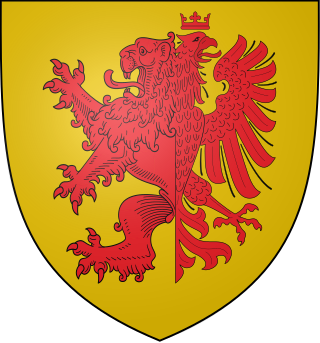
The Aldobrandeschi family was an Italian noble family from southern Tuscany.

The County of Santa Fiora, also known as State of Santa Fiora was a small historical state of southern Tuscany, in central Italy. Together with the county of Sovana, it was one of the two subdivisions into which the possessions of the Aldobrandeschi, then lords of much of southern Tuscany, were split in 1274.

Istia d'Ombrone is a small town in southern Tuscany, Italy, a frazione of the comune of Grosseto.

Inferno is the first part of Italian writer Dante Alighieri's 14th-century epic poem Divine Comedy. It is followed by Purgatorio and Paradiso. The Inferno describes Dante's journey through Hell, guided by the ancient Roman poet Virgil. In the poem, Hell is depicted as nine concentric circles of torment located within the Earth; it is the "realm ... of those who have rejected spiritual values by yielding to bestial appetites or violence, or by perverting their human intellect to fraud or malice against their fellowmen". As an allegory, the Divine Comedy represents the journey of the soul toward God, with the Inferno describing the recognition and rejection of sin.

Paradiso is the third and final part of Dante's Divine Comedy, following the Inferno and the Purgatorio. It is an allegory telling of Dante's journey through Heaven, guided by Beatrice, who symbolises theology. In the poem, Paradise is depicted as a series of concentric spheres surrounding the Earth, consisting of the Moon, Mercury, Venus, the Sun, Mars, Jupiter, Saturn, the Fixed Stars, the Primum Mobile and finally, the Empyrean. It was written in the early 14th century. Allegorically, the poem represents the soul's ascent to God.
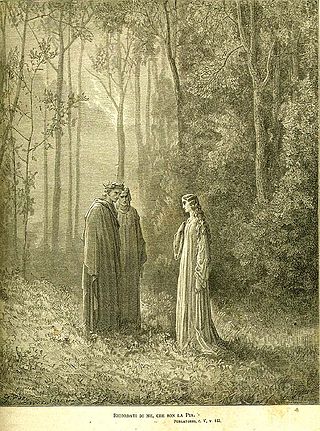
Pia de' Tolomei was an Italian noblewoman from Siena identified as "la Pia," a minor character in Dante's Divine Comedy who was murdered by her husband. Her brief presence in the poem has inspired many works in art, music, literature, and cinema. Her character in the Divine Comedy is noted for her compassion and serves a greater program among the characters in her canto, as well as the female characters in the entire poem.

Guido Guerra V (1220-1272) was a politician from Florence, Italy. Aligned with the Guelph faction, Guerra had a prominent role in the political conflicts of mid-thirteenth century Tuscany. He was admired by Dante Alighieri, who granted him honor in the Divine Comedy, even though he placed Guerra in Hell among sinners of sodomy.

Bonconte I da Montefeltro was an Italian Ghibelline general. He led Ghibelline forces in several engagements until his battlefield death. Dante Alighieri featured Montefeltro as a character in the Divine Comedy.
Giovanna da Montefeltro was a thirteenth-century Italian noblewoman and the wife of Bonconte I da Montefeltro. She is referenced by Dante Alighieri in his Divine Comedy for not remembering her late husband in her prayers.
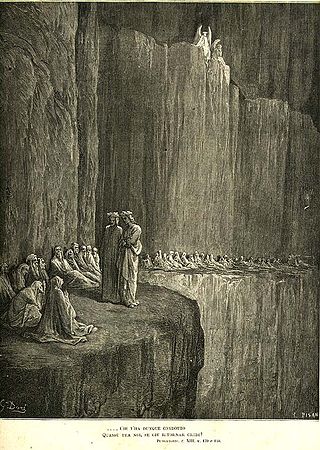
Sapia Salvani was a Sienese noblewoman. In Dante Alighieri's Divine Comedy, she is placed among the envious souls of Purgatory for having rejoiced when her fellow Sienese townspeople, led by her nephew Provenzano Salvani, lost to the Florentine Guelphs at the Battle of Colle Val d'Elsa.

The third circle of hell is depicted in Dante Alighieri's Inferno, the first part of the 14th-century poem Divine Comedy. Inferno tells the story of Dante's journey through a vision of the Christian hell ordered into nine circles corresponding to classifications of sin; the third circle represents the sin of gluttony, where the souls of the gluttonous are punished in a realm of icy mud.